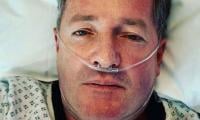Chernobyl’s ongoing toll
In 1996, the International Atomic Energy Agency (IAEA) stated that Chernobyl was “the foremost nuclear catastrophe in human history”. In 2005, the IAEA and World Health Organisation (WHO) set out their united view: “The magnitude and scope of the disaster, the size of the affected population, and the long-term consequences make it, by far, the worst industrial disaster on record.
“Chernobyl unleashed a complex web of events and long-term difficulties, such as massive relocation, loss of economic stability, and long-term threats to health in current and, possibly, future generations.” In 2006, the independent TORCH (The Other Report on Chernobyl) report examined the health evidence. However thousands of scientific articles have been published since then.
These are discussed in a new TORCH-2016 report commissioned by Friends of the Earth Austria and funded by the City Government of Vienna. It clearly indicates that the adverse effects from Chernobyl are continuing. The accident had many consequences, including economic, ecological, social and political effects. TORCH-2016 focuses on the health effects, and clearly shows they were and are manifold, severe, widespread, and long-lasting.
The headline estimate of 40,000 future cancer deaths is derived from the collective dose estimate of 400,000 person sieverts by the United Nations Scientific Committee on the Effects of Atomic Radiation (UNSCEAR) in 2011.
This figure is multiplied in TORCH-2016 by the currently accepted risk of fatal cancer from radiation (10 percent per person sievert) to arrive at an expected 40,000 fatal cancers in future. This is a valid routinely-used estimation method using the official linear no-threshold (LNT) model of radiation risks. The 40,000 figure is the same order of magnitude as other academic estimates.
The accident contaminated over 40 percent of Europe. The problem with nuclear power is that it can be supremely unforgiving: when things go wrong – as at Chernobyl (and Fukushima in 2011) – they can go very, very wrong indeed. Contaminating over 40 percent of Europe plus an estimated 40,000 deaths are pretty disastrous effects.
It is vital that governments learn from the Chernobyl and Fukushima accidents. Many governments are phasing out their nuclear plants, but regrettably, a few governments – including the UK government and even that of Belarus, which suffered the brunt of Chernobyl’s fallout – have decided to ignore the lessons of Chernobyl and Fukushima and are planning or constructing more nuclear power stations.
In 2005, the IAEA/WHO stated: “What the Chernobyl disaster has clearly demonstrated is the central role of information and how it is communicated in the aftermath of radiation or toxicological incidents. Nuclear activities in Western countries have also tended to be shrouded in secrecy.
“The Chernobyl experience has raised the awareness among disaster planners and health authorities that the dissemination of timely and accurate information by trusted leaders is of the greatest importance.”
To re-establish that trust will be difficult. At a minimum, it will require the following steps. First, governments make it clear to their citizens that they will consider safer energy options that do not have the potential for another Chernobyl or Fukushima. Many such options exist.
Second, a dialogue to be set up between agencies such as IAEA, WHO and national governments on the one hand and various NGOs and health charities on the other for exchanges of views on radiation risks. Transparency is essential.
Third, WHO should no longer be required to have its reports on radiation matters vetted by the IAEA, as presently required under the 1959 agreement between the two UN agencies.
Fourth, UN agencies WHO, UNSCEAR, IAEA should be required to have independent scientists from NGOs and health charities as members of their main Committees. These agencies should also be required to consult on their draft reports, including the convening of meetings with environment NGOs and independent health charities.
This article has been excerpted from: ‘Chernobyl’s ongoing toll: 40,000 more cancer deaths?’
Courtesy: Counterpunch.org
-
 Nobel Foundation Reaffirms Its Core Responsibility To ‘safeguard The Dignity Of The Nobel Prizes’
Nobel Foundation Reaffirms Its Core Responsibility To ‘safeguard The Dignity Of The Nobel Prizes’ -
 Prince William, Kate Middleton Warned Of Meghan Markle’s UK Return
Prince William, Kate Middleton Warned Of Meghan Markle’s UK Return -
 Melissa Leo Reveals How Winning An Oscar Made Things Worse
Melissa Leo Reveals How Winning An Oscar Made Things Worse -
 Piers Morgan In Hospital: Here's Why
Piers Morgan In Hospital: Here's Why -
 IPhone 18 Pro Leaked: New Design Reveals Radical Corner Camera Layout
IPhone 18 Pro Leaked: New Design Reveals Radical Corner Camera Layout -
 Kung Fu Legend Siu-Lung Leung Passes Away At 77
Kung Fu Legend Siu-Lung Leung Passes Away At 77 -
 Kim Kardashian To Remove Ex Kanye West From Her Kids' Names
Kim Kardashian To Remove Ex Kanye West From Her Kids' Names -
 Queens Mother Arrested After Abducting Child From Court-ordered Visit
Queens Mother Arrested After Abducting Child From Court-ordered Visit -
 Sarah Ferguson Ready To ‘spread Her Wings’ After Separating From ‘disgraced’ Andrew
Sarah Ferguson Ready To ‘spread Her Wings’ After Separating From ‘disgraced’ Andrew -
 Finn Wolfhard Shares How Industry Views Him Post 'Stranger Things'
Finn Wolfhard Shares How Industry Views Him Post 'Stranger Things' -
 Dylan O'Brien Gets Nostalgic After Reunion With Old Friend
Dylan O'Brien Gets Nostalgic After Reunion With Old Friend -
 UK Doctors Warn Screen Time Is Harming Children’s Health
UK Doctors Warn Screen Time Is Harming Children’s Health -
 Meghan Markle To Get Police Protection In UK If Travelling With Archie, Lilibet
Meghan Markle To Get Police Protection In UK If Travelling With Archie, Lilibet -
 Spencer Pratt Expresses Hope For Taylor Swift, Travis Kelce's Wedding Invite
Spencer Pratt Expresses Hope For Taylor Swift, Travis Kelce's Wedding Invite -
 Evan Peters Makes Unexpected Confession About 'American Horror Story' Season 13
Evan Peters Makes Unexpected Confession About 'American Horror Story' Season 13 -
 Kentucky Grandmother Arrested After Toddlers With Broken Skulls, Ribs
Kentucky Grandmother Arrested After Toddlers With Broken Skulls, Ribs



